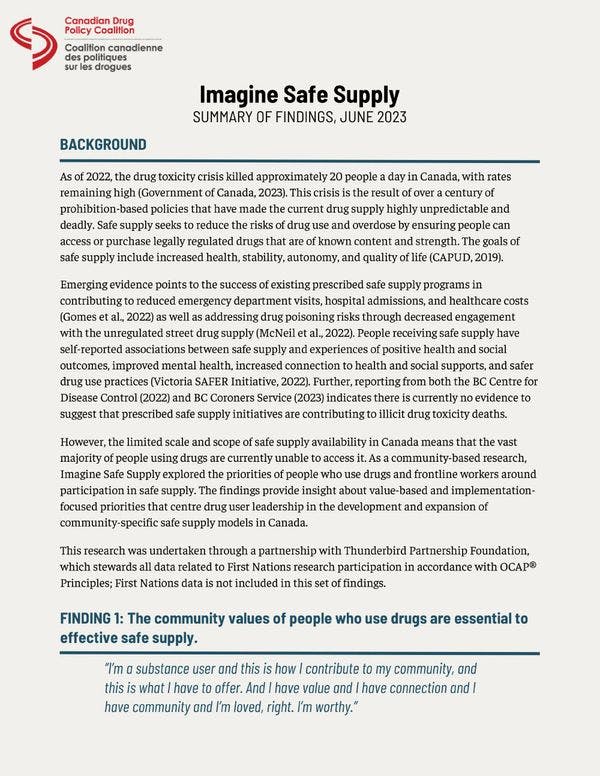Imaginar un suministro seguro - Resumen de conclusiones
La Coalición Canadiense sobre Políticas de Drogas ofrece información sobre prioridades basadas en valores y centradas en la implementación que centran el liderazgo de las personas usuarias de drogas en el desarrollo y la expansión de modelos de suministro seguro en Canadá. Más información, en inglés, está disponible abajo.
As of 2022, the drug toxicity crisis killed approximately 20 people a day in Canada, with rates remaining high (Government of Canada, 2023). This crisis is the result of over a century of prohibition-based policies that have made the current drug supply highly unpredictable and deadly. Safe supply seeks to reduce the risks of drug use and overdose by ensuring people can access or purchase legally regulated drugs that are of known content and strength. The goals of safe supply include increased health, stability, autonomy, and quality of life (CAPUD, 2019).
Emerging evidence points to the success of existing prescribed safe supply programs in contributing to reduced emergency department visits, hospital admissions, and healthcare costs (Gomes et al., 2022) as well as addressing drug poisoning risks through decreased engagement with the unregulated street drug supply (McNeil et al., 2022). People receiving safe supply have self-reported associations between safe supply and experiences of positive health and social outcomes, improved mental health, increased connection to health and social supports, and safer drug use practices (Victoria SAFER Initiative, 2022). Further, reporting from both the BC Centre for Disease Control (2022) and BC Coroners Service (2023) indicates there is currently no evidence to suggest that prescribed safe supply initiatives are contributing to illicit drug toxicity deaths.
However, the limited scale and scope of safe supply availability in Canada means that the vast majority of people using drugs are currently unable to access it. As a community-based research, Imagine Safe Supply explored the priorities of people who use drugs and frontline workers around participation in safe supply. The findings provide insight about value-based and implementation focused priorities that centre drug user leadership in the development and expansion of community-specific safe supply models in Canada.
This research was undertaken through a partnership with Thunderbird Partnership Foundation, which stewards all data related to First Nations research participation in accordance with OCAP® Principles; First Nations data is not included in this set of findings.
Descargas
Temas
Regiones
Perfiles relacionados
- Thunderbird Partnership Foundation
